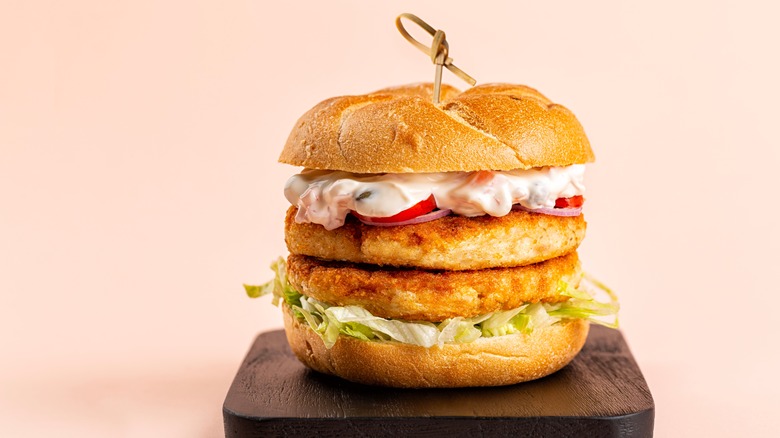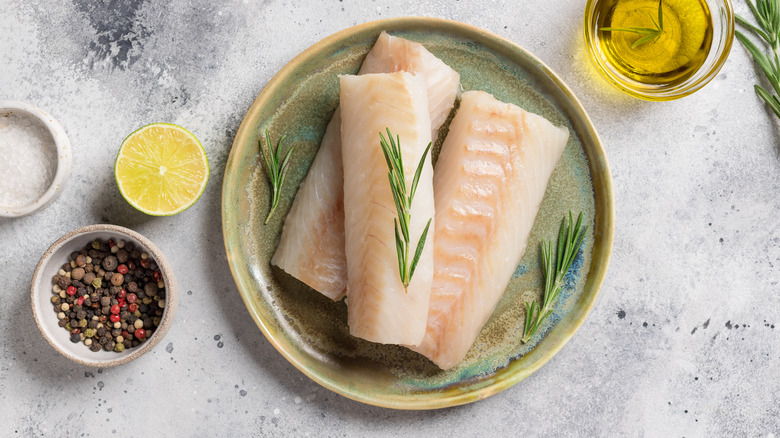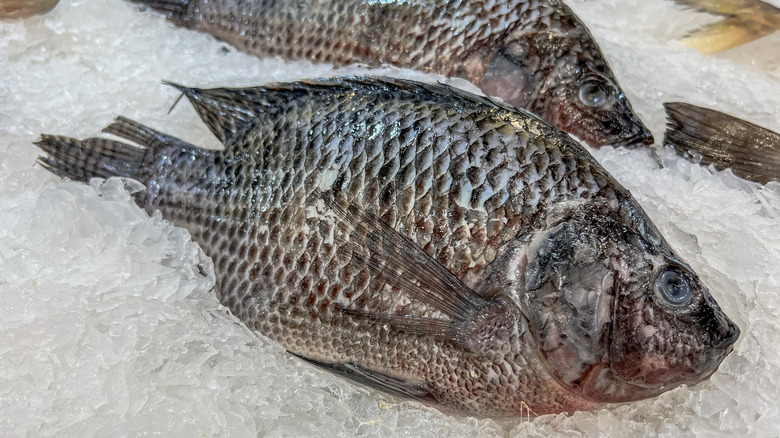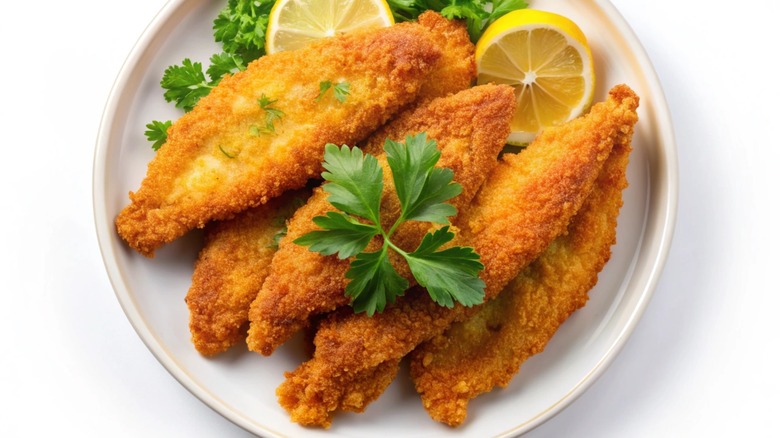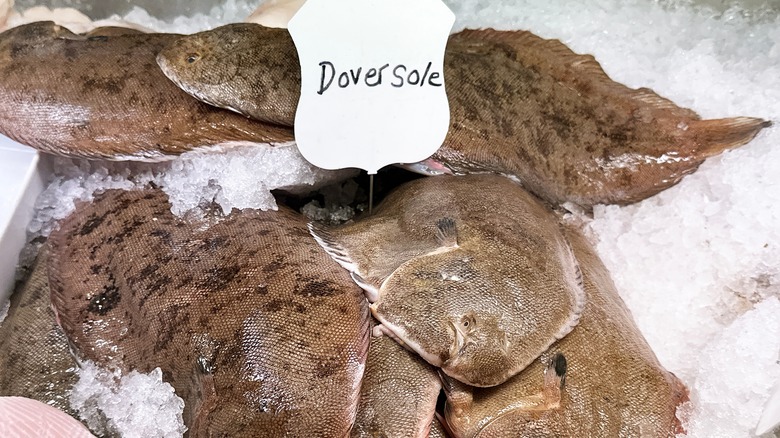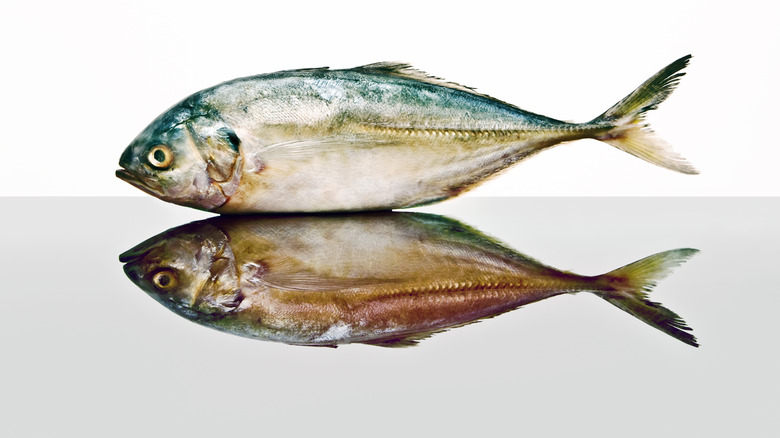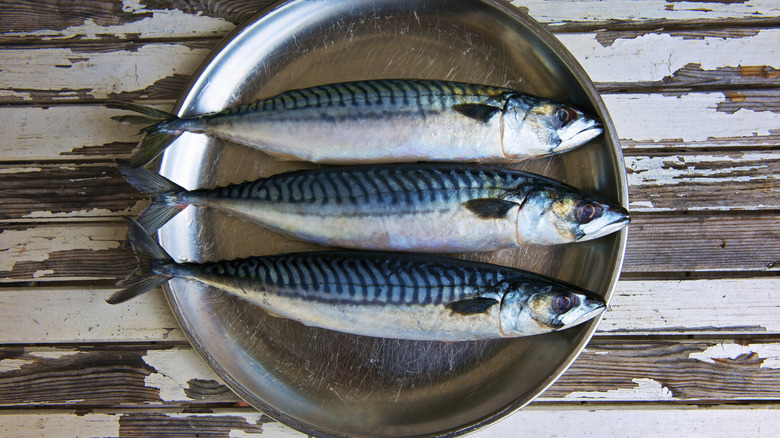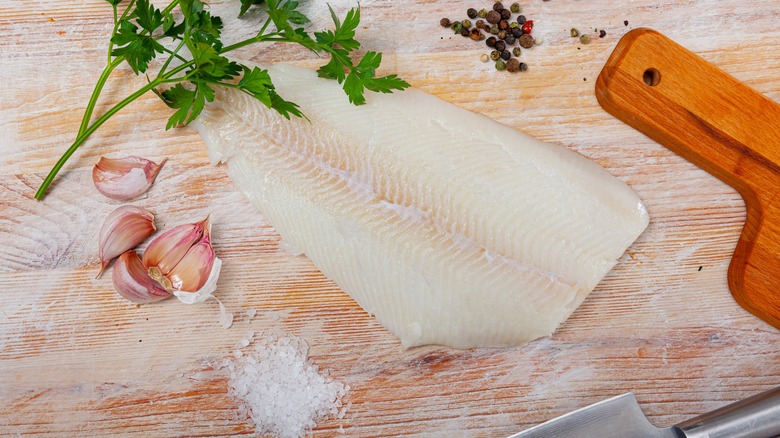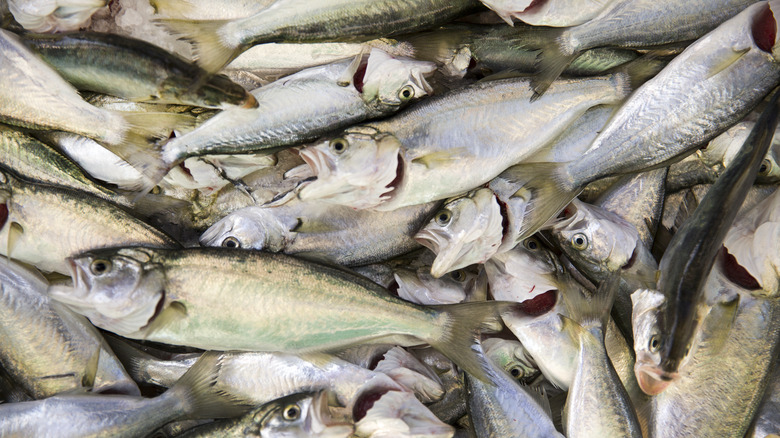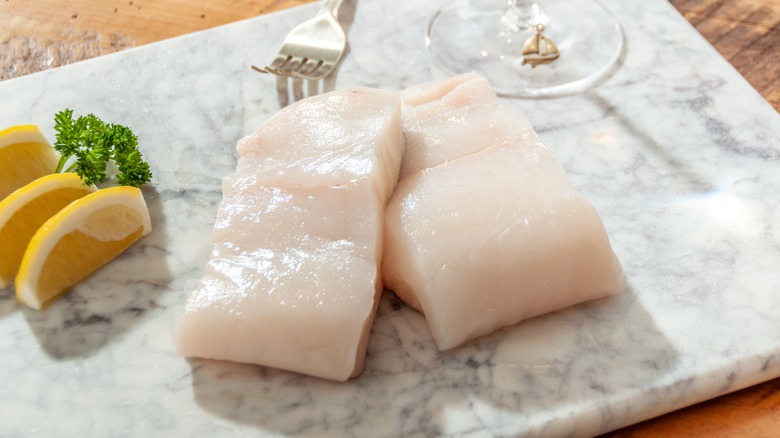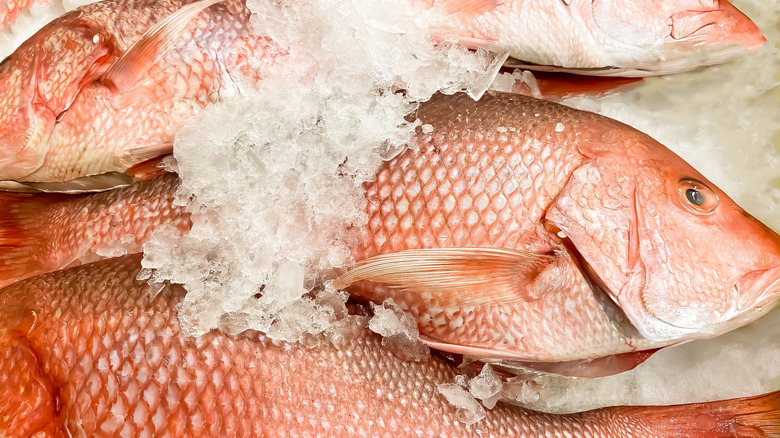12 Best And Worst Types Of Fish To Use When Cooking Fish Sandwiches, According To Experts
There's something inexplicably satisfying about a classic fish sandwich. The briny taste of seafood, the tang of tartar sauce, and the soft sweetness of the bun all blend together to create the perfect, delectable bite. And while certain fish are no-brainers for this type of preparation, there are other varieties out there that don't quite fit the criteria required to make the cut.
We talked to a few food experts to get their input on which fish varieties should be at the top of your grocery list the next time you're making fish sandwiches — and which you should avoid altogether — to deliver a delicious and mouthwatering final dish, every time. Read on to explore what made the cut for fish sandwiches (and what didn't), according to food aficionados Sally Cameron, chef and owner of A Food Centric Life, and Allie Hagerty, food blogger and recipe creator at Seasoned and Salted.
1. Buy: Cod
Cod is commonly recommended for fish sandwiches, and for good reason. This delicious fish is a low-fat source of protein that is not only good for your heart, weight management, and even your cognitive function, but also tastes delicious. Known for its mild flavor, cod is a crowd-pleaser. Perfect for those who don't enjoy fishy tasting fish, it has a firm texture and low oil content, which makes it ideal for sandwiches because it holds together well on bread or in a bun.
"For home cooks with less experience, start with cod or haddock. They're easy to cook and forgiving if you overcook them a little," recommends Allie Hagerty. Sally Cameron agrees. "[A] good fish for fish sandwiches is cod, which is light, mild, and flaky, and widely available. It can be battered and fried crisp, served with a nice tartar sauce on a soft roll or bun."
Another bonus? You can cook cod in a plethora of different ways, from baking to grilling to frying, for maximum variety and versatility.
2. Avoid: Tilapia
Though tilapia can be a controversial fish because it's almost exclusively farm-raised, it still has plentiful health benefits like high levels of omega-3 fatty acids, vitamin B12, and choline. And while it also has a delicious, mild taste similar to cod, it has a decidedly different texture.
"I'd avoid delicate fish like tilapia or Dover sole — they can fall apart too easily and don't have the right texture [for sandwiches]," explains Allie Hagerty. Tilapia is often described as "tender," which is code for "it easily falls apart." While this makes it ideal for certain preparations, like baking or steaming, it also means the fish will quickly crumble when placed in a sandwich.
Instead, try baking tilapia with a lemon garlic sauce or using it as the centerpiece of a shawarma pita platter. In these two preparations, the fish is meant to be delicate and flaky, so it's no problem if the filets start to fall apart on your plate — or even while cooking.
3. Buy: Haddock
"The most popular here in New England is haddock for sandwiches," explains Allie Hagerty. "For fish sandwiches, I love using mild, flaky white fish like haddock [because it will] hold up well when fried or baked, have a neutral flavor that pairs perfectly with toppings, and offer that classic fish sandwich! " she adds.
Like cod, haddock is a flaky white fish. It does, however, have a more distinct flavor that is slightly briny and sweet but still mild. This gives it a subtle fishy flavor that isn't too overpowering, so it pairs well with a range of other flavors. Haddock is a popular choice for fried preparations, and it can often be found as the star of fish-and-chips meals. If you're looking to create a classic fried fish sandwich with a lot of crunch, haddock is your answer. But if fried fish isn't your thing, don't worry — you can also bake, pan-fry, or poach this versatile seafood.
4. Avoid: Dover sole
While Dover sole is a delicious and healthy fish, there are a few reasons it's not a good candidate for fish sandwiches — the first being the price. Dover sole tends to come with a higher price tag than other fish, because it is primarily farmed or fished in Europe and then imported. At some retailers, it can be nearly twice the price of other white fish like haddock.
While the price alone is a deterrent, Dover sole also has a distinctly mild, sweet flavor. While this makes it delicious in simple preparations, the flavor often gets masked when combined with multiple other ingredients in a sandwich (especially a fried fish sandwich). It's also a small-flaked fish, which can lead the filet to fall apart in just a few bites. So unless you've got money to burn, we'd recommend looking elsewhere the next time fish sandwiches are in your weekly meal plan.
5. Buy: Pollock
Like haddock, pollock is another popular option for fish sandwiches — especially the iconic handhelds we all know and love from major fast-food chains. "When I think of fish sandwiches, I think of fast food, such as fish sandwiches from McDonald's and their Filet-O-Fish sandwich (which is made with Alaskan pollock)," says Sally Cameron. "They use it because it is mild, flaky, and cost-effective for their market."
This seafood variety is a flaky, white fish with a subtle and slightly sweet flavor. It also has a medium texture, meaning it walks the line between too firm and too soft for sandwiches (which explains why it's so popular). It also has a higher fat content than similar fish like haddock or cod, giving it a bit more flavor to help leave you feeling satisfied after your meal. If you want the taste of a fish sandwich but are watching your carb intake, pollock is also a perfect option for fish sticks. You'll achieve nearly the same flavor as a fish sandwich but without the bun.
6. Avoid: Mackerel
Mackerel has a distinct fishy taste that can be a polarizing choice in any dish. When it's not consumed right away, it can develop a potent, ultra-fishy flavor that is off-putting for many — especially for diners who tend to prefer mild fish like cod or tilapia.
Mackerel is considered one of the most nutritious types of fish because it's bursting with nutrients like protein, B vitamins, selenium, and copper. It's also extremely high in omega-3 fatty acids (which is what gives it that potent, sometimes oily flavor). While the health benefits are undeniable, experts recommend looking elsewhere when sourcing fish for your next batch of sandwiches.
"Steer clear of overly oily fish like mackerel for sandwiches, as its strong flavors can be overpowering," recommends Allie Hagerty. If you do decide to go for it and use mackerel in your sandwich, you can help offset the oily, strong fish flavor with sweeter toppings like fruit. A mango salsa, for example, will be a bright and fresh contrast to the oily and salty fish.
7. Buy: Halibut
Halibut is a clear winner for fish sandwiches, with high praise from both experts. "When it comes to flavor, I think halibut takes the win — it's meaty, mild, and pairs beautifully with tangy or spicy condiments," says Allie Hagerty. Sally Cameron agrees, though she cautions to choose your halibut wisely to stay within budget. "I'd use the leaner, thinner filets from [south Pacific] halibut versus the thicker (and much more expensive) Alaskan halibut filets which are better for roasting, baking, pan-frying and other preparations."
All varieties of halibut are mild and slightly sweet, with a nice firm texture. This subtle flavor makes it the perfect vessel for sandwiches, because it can be mixed and matched with different spices and toppings to create a meal that's one-of-a-kind. During your next trip to the grocery store, "look for firm, translucent flesh with no 'fishy' smell," Hagerty recommends. "Skin-on filets can help the fish hold together better during cooking, so consider those if you're baking or frying."
8. Avoid: Bluefish
Like mackerel, bluefish is known for its fishy flavor. While this affordable fish is a great source of vitamins and minerals like B12, selenium, and potassium, it's also an acquired taste that many people avoid. Once caught, bluefish need to be properly cleaned and put on ice right away to help prevent a potent taste from developing. And the fresher the better — when bluefish sit, the pungent flavor begins to grow, making them even more unpalatable to those who don't enjoy the taste.
While this is easy to monitor if you're doing the fishing yourself, it's best to avoid bluefish otherwise. When purchasing from the store, you can't guarantee when the fish was caught or how it was prepped, so you'll be taking a gamble on the fishy level of flavor. This can leave you disappointed with the final outcome of your sandwich (especially if you tend to gravitate toward the mild taste of haddock or cod).
9. Buy: Monkfish
Want to up your fish sandwich game with an unexpected variety? "For something a bit more unusual, try monkfish — [it has] a firmer texture and unique flavor that can elevate your sandwich," Allie Hagerty describes. Monkfish gets its unusual flavor thanks to its unusual diet. This deep-sea dweller crawls along the bottom of the ocean and eats a wide variety of smaller fish and crustaceans (unlike most other fish), giving it a distinctive taste when cooked. Just don't be deterred by monkfish's startling appearance before it has been processed — it's usually sold in the store already filleted.
While monkfish's taste is often compared to lobster, its versatility is nearly unmatched. You can bake, broil, poach, or fry this hearty fish to create almost any dish. For sandwiches, consider pan-frying a breaded filet, or recreating "lobster" rolls on a buttered bun. Though dramatically different, these two preparations are both delicious and affordable, thanks to monkfish's low price tag (especially when compared to real lobster).
10. Avoid: Sea bass
While sea bass is a delicious fish with a delicate texture, it comes with one major downside: the price. "Avoid splurging on fish like sea bass or snapper for sandwiches; their flavors are delicate and better showcased in simpler preparations," explains Allie Hagerty. This fish's clean, sweet, and buttery flavor is highly sought after and delicious when steamed, poached, or baked.
Often clocking in at about $60 per pound for the Chilean variety, it comes with a sky-high price tag compared to similar fish. While the cost is understandable because of the complexity of fishing this scarce breed, it's not usually worth it when the flavor is masked in a sandwich. Though there are now fisheries in the Mediterranean that farm sea bass to help make it more affordable, it's best to stick with other types of white fish like haddock, cod, or pollock to keep your costs low.
11. Buy: Catfish
Fried catfish is a Southern staple — and continuing this tradition in your fried fish sandwiches will help you create a flavorful meal. "If you're looking for cost-effective options, catfish is a great choice. It's budget-friendly but still delivers on taste," explains Allie Hagerty.
This mild, slightly sweet fish is flaky and tender like many of our recommendations. But unlike other fish varieties, catfish is also sometimes compared to chicken, making it ideal for those who typically avoid seafood. Though it has a mild flavor, there is a lot of range within the species depending on whether it's wild-caught or farmed, as well as the waters where it's harvested.
To get a crispy, delicious fry on your catfish, first soak it in water, then move it to a milk or buttermilk bath. Coat the catfish in your choice of breading, like cornmeal or flour, and add your favorite seasonings. Deep fry it either in a fryer or in a pan on the stovetop until crisp and golden brown. Finally, place it between your favorite bun and top it with a classic tartar sauce for a simple and delicious sandwich.
12. Avoid: Red snapper
While red snapper is a widely beloved white fish, it's not our favorite choice for fish sandwiches. This delicious seafood has a sweet flavor that stands well on its own with just a few mild spices and simple preparations like grilling, steaming, baking, or poaching. Even if baked with just lemon and herbs, adding this fish to a sandwich with sauces and other toppings can quickly mask the delicate flavor.
Red snapper also comes with a hefty price tag. Usually around $30 per pound for filets, red snapper comes at a premium — especially compared to super affordable white fish varieties like cod that cost about half the price. Though red snapper offers healthy nutrients like omega-3 fatty acids, vitamins D and E, and selenium, it's best reserved for dishes where its subtle flavor will be the star — instead of paired with a bun and other toppings on a tasty sandwich. Try baking it with a delicious herb crust to really enhance the taste.
